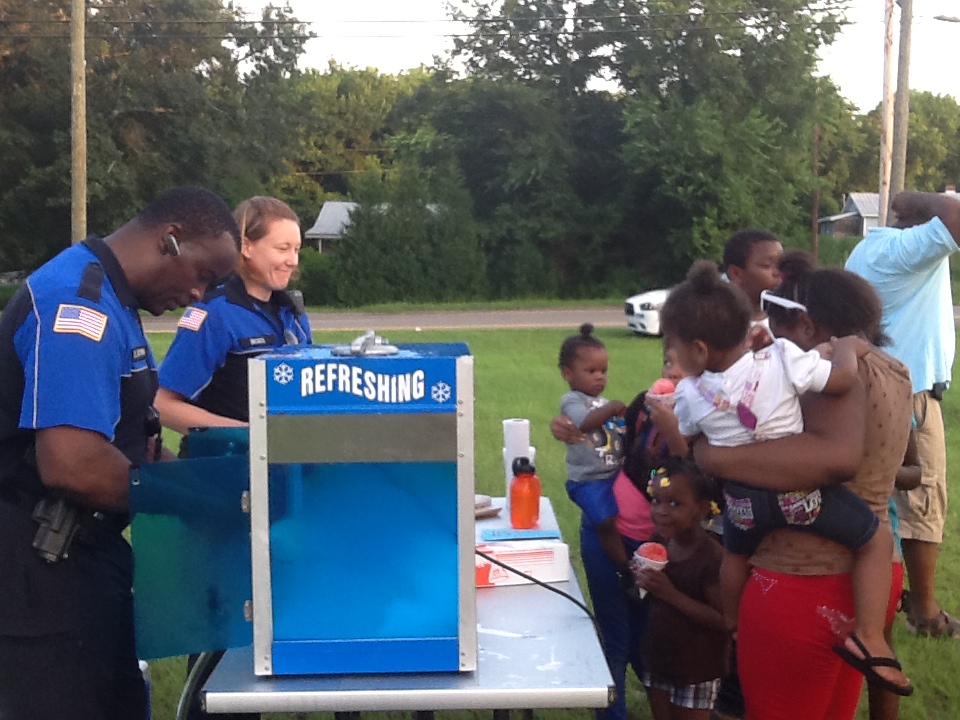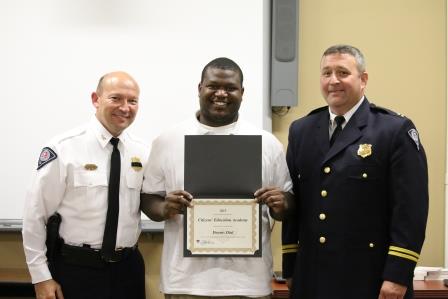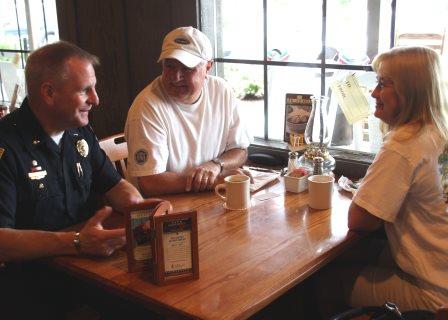The concept of community policing emerged from the civil unrest in the 1960s as a means for law enforcement to respond to the needs of increasingly diverse American communities. However, community policing did not gain widespread acceptance until the 80s.
Modern-day, community policing focuses on developing local partnerships and relationships to increase trust and cooperation through prevention, problem solving and community engagement, in addition to traditional law enforcement duties. To be effective, community policing cannot be assigned to just one special unit or group of officers. It must be a mindset for the entire department. It calls for partnerships to be cultivated in good times rather than just during a crisis.

The Aiken Public Safety Department creates opportunities for engagement
between the department and community that are mobile and diverse.
There are several ingredients to a successful community policing program, according to Aiken Chief Charles Barranco.
First, is proactive relationships, Barranco said. It’s vital that law enforcement takes every opportunity, such as foot patrols and bicycle patrols, to engage with their community outside of conducting official policing duties.
Second, it’s important to decentralize. In a lot of communities, "headquarters" may be closely associated with bookings, fingerprinting and mugshots, Barranco said.
"These are all a part of the process that, all too often, conjures memories or thoughts of negative experiences," Barranco said. "It is good to have satellite offices for public safety when possible. This helps remove relationship barriers and allows officers to be viewed more as a part of the community."
Another factor is officer selection. Barranco said assessing an officer’s personality and natural tendencies to engage is very important when making decisions on employment, promotion and specialized assignments such as investigators or school resources officers.
Departments also need to have a service-oriented philosophy which encourages all staff to look at ways to make communities safer through partnerships that provide services to the community. These relationships can result in lower crime rates, increased engagement and productive relationships.
"This is opposed to the traditional ‘arrest your way out of crime’ approach," Barranco said.
Partnerships with neighborhood organizations—as well as other civic, faith-based and service provider organizations—are key in making community policing successful, Barranco said. The Aiken Public Safety Department works with organizations such as Christ Central, The United Way of Aiken County and Goodwill Job Connection, among others.
Barranco said the department creates opportunities for engagement between the department and community that are mobile and diverse. Some of their recurring events include Mobile Movie Nights, Sno-Cone Days, Chat with Chief, Coffee with a Cop, Poetry in the Park, Bikes and Books, Citizens Academy and the Community Café series.
"This encourages stakeholders to be comfortable in having discussions with law enforcement," he said. "We also enjoy and promote meeting people where they are, in their neighborhoods."
Community policing requires a firm foundation within the entire organization for it to be successful, echoed Police Chief Eric Williams of the Town of Kingstree. Everyone in the department must understand the expectations and buy into the process, he said.
Police also must have a thorough knowledge of their community and its problems and issues. The core issues of community policing are timely intervention, early detection and stressing prevention.
"A proactive approach is essential to maintain and grow your efforts," Williams said.
Partnerships should stem from entities within the law enforcement agencies and organizations that represent individuals, groups, businesses and neighborhoods, he said. Law enforcement can reach out to the community through schools, extracurricular activities, public forums, facility security assessments, or even door-to-door "knock and talks," he said.
Successful community policing involves trust, and that requires a mostly free flow of information from the department to the community, according to City of Greenville Police Chief Ken Miller. Police can reach out to communities through social media and technology, but they also require some face-to-face time.
Greenville’s Community Response Team officers are assigned jurisdictions in the city. This Neighborhood Policing Zone Initiative establishes geographic zones of responsibility for lieutenants. This creates enhanced personal relationships and a designated point of contact within the department for neighborhoods citywide. It also results in accountability for problem solving, crime reduction strategies and communication with the department, Miller said.
Like many cities, Greenville offers a citizen’s police academy to familiarize residents with police officers and the work they do to keep communities safe. The city is also developing a high school academy.

Greenville offers a citizen’s police academy to familiarize residents with
police officers and the work they do to keep communities safe.
In addition, Greenville officers frequently meet with business associations to discuss crime or public safety issues. Plus they participate in numerous outreach efforts, such as toy drives for disadvantaged youths and coat drives for the homeless, Miller said.
"Policing still centers on order maintenance and crime prevention," Miller said. "But the safest communities are those where police aren’t just enforcing the law. The community is taking an active role in its own well-being."
The Town of Pendleton currently is in the process of reinstituting its police department after town officials disbanded the old force in 2004 due to rising costs. The new department provides the town with a unique opportunity to start on the right footing without having to overcome institutional resistance to community policing, said Pendleton’s Police Chief Doyle Burdette.
Burdette said one of the first programs the department plans on implementing is a Citizens Assistance Program designed to help seniors who live alone to be able to stay in their homes longer. The department will partner with the U.S. Postal Service, Meals on Wheels and other organizations which serve seniors, and officers can check on the senior’s well-being through visits or phone calls on a daily basis.
Burdette said his department also will use the Scanning, Analysis, Response and Assessment model of community policing to devise other ways to serve the community. The idea is to scan the community and identify problems, analyze the problem and identify the causes, respond to the problem by collaborating on a solution involving the community, and then assess the plan after it is implemented and make any necessary adjustments.
Burdette laid out a hypothetical situation about a neighborhood that has a drug problem. The department identifies the problem is occurring predominantly between 7 p.m. and midnight, and it involves primarily young men between the ages of 16 – 22 on an area of the street where there are no street lights.
By working with the Public Works Department, the city can have the lighting fixed on that street. The residents in the community can call the police when they see suspicious activity and then have a patrol car ride down the street in order to hamper the drug dealers’ ability to conduct business. The department could also work with community service groups, schools, and churches to offer activities such as evening basketball which would offer the people involved with the criminal activity something else to do with their time.
"Once we devise a good plan with the buy-in of the community, we implement the plan and make changes as necessary," Burdette said."
There are challenges to the concept of community policing, among them connecting to disengaged communities. "We’re only as safe as the community will help us to be," said Greenville’s Chief Miller. "Advances in law enforcement such as crime mapping technology are great, but they are limited in how much they help if nobody’s engaged."
Some communities have a general mistrust of police officers and are unwilling to share information about neighborhood crimes with them. The information is essential both to police enforcement and prevention efforts.
"On both sides of the table–community and law enforcement–there is often misunderstanding and a lack of trust that is unfounded," said Aiken’s Chief Barranco. "The challenge then is for both sides to hear what the other has to say and begin to correct the misinformation with action–not more talk."
Kingstree’s Chief Williams said officers realize that simply by doing their job, they may not always be pleasing some people in the community. People may not always agree, but they should try to maintain respect toward each other.
"The key is presenting consistency and transparency so when these challenges arise you have already built a foundation where you can hopefully get to the mentioned alternative. The public safety arena cannot and should not expect to be most effective alone. It will take the combined effort of all parties to be most effective," Williams said.

